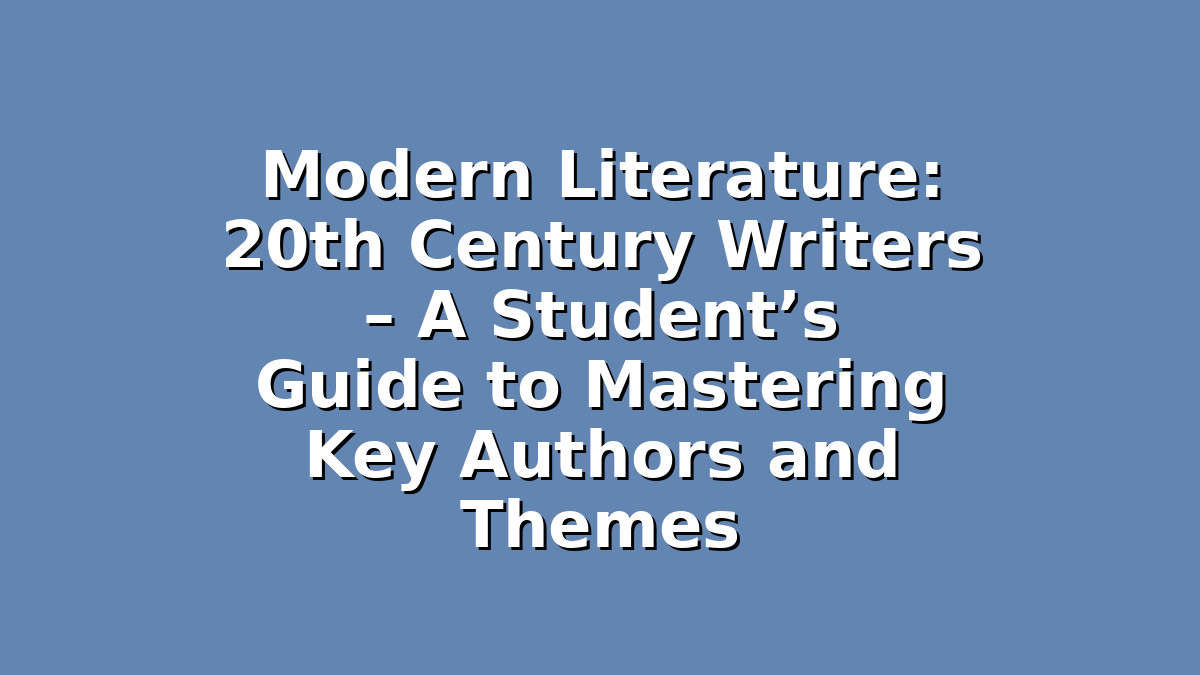If you’re a student preparing for exams or simply aiming to deepen your understanding of literature, the world of 20th-century writers offers a rich and fascinating field to explore. Modern literature from this era reflects dramatic social changes, innovative narrative techniques, and diverse voices that shaped the literary landscape we know today. However, the vast number of authors, styles, and contexts can sometimes feel overwhelming. This guide will help you navigate the essential aspects of 20th-century literature with practical study tips, so you can approach your exams with confidence and curiosity.
Understanding the Context: Why 20th Century Literature Matters
Before diving into specific authors and works, it’s important to understand why 20th-century literature holds such significance. This period saw two World Wars, rapid technological advances, shifts in social norms, and evolving political ideologies—all of which are reflected in the literature of the time. Writers experimented with form and content, breaking away from traditional storytelling to capture the complexities of the modern world.
Study tip: Start your revision by building a timeline of major historical events alongside key literary movements such as Modernism, Postmodernism, and the Harlem Renaissance. This will help you link the themes and styles of the literature with the social and political climate, making your essays and answers more insightful.
Section 1: Key 20th Century Writers and Their Contributions
Focusing on some of the most influential writers will give you a solid foundation. Here are a few pivotal figures you should know:
– James Joyce: Known for his stream-of-consciousness technique, Joyce’s works like *Ulysses* and *A Portrait of the Artist as a Young Man* challenge traditional narrative forms. His writing explores identity, time, and memory in innovative ways.
– Virginia Woolf: A central figure in Modernism, Woolf’s novels like *Mrs Dalloway* and *To the Lighthouse* delve into characters’ internal experiences and the fluidity of time.
– T.S. Eliot: As a poet and critic, Eliot’s *The Waste Land* is a landmark modernist poem that captures the disillusionment of the post-war generation.
– Langston Hughes: A leading voice of the Harlem Renaissance, Hughes’s poetry and prose emphasize African American culture, racial pride, and social justice.
– George Orwell: Famous for *1984* and *Animal Farm*, Orwell’s works are critical explorations of power, totalitarianism, and political ideology.
Study tip: Create character maps and theme charts for each author’s major works. Summarize key quotes and identify literary devices used. This will make it easier to compare and contrast authors during exams and write coherent essays.
Section 2: Analyzing Themes and Literary Techniques
20th-century literature is not just about what is told, but how it is told. Understanding recurring themes and literary techniques is crucial:
– Alienation and Fragmentation: Reflecting the fractured modern world, many writers explore feelings of isolation and disconnectedness.
– Stream of Consciousness: A narrative style that attempts to depict the continuous flow of characters’ thoughts and feelings.
– Symbolism and Imagery: Complex symbols often replace straightforward descriptions, requiring careful interpretation.
– Social Critique: Many works challenge societal norms, politics, and inequality.
Study tip: When reading, annotate your texts by highlighting passages that illustrate these themes and techniques. Write short notes in the margins or in a notebook explaining their significance. Practicing close reading will improve your analytical skills and help you spot exam-worthy points.
Section 3: Effective Study Strategies for Exam Success
Preparing for literature exams can be challenging, but with the right approach, you can master 20th-century writers efficiently:
– Active Reading: Don’t just passively read texts; engage with them by asking questions like “What is the author trying to say here?” or “How does this technique affect the reader?”
– Practice Essay Writing: Use past exam questions or prompts to practice structuring clear, focused essays. Always support your arguments with textual evidence.
– Group Discussions: Talking about these works with peers can open new perspectives and deepen your understanding.
– Use Diverse Resources: Supplement your reading with study guides, video lectures, and literary critiques to get multiple viewpoints.
– Timely Revision: Break your revision into manageable chunks, focusing on one author or theme at a time, rather than cramming.
Study tip: Develop a revision timetable that includes specific goals for each session. Include time for reading, note-making, essay practice, and review. Regular self-testing helps reinforce your knowledge and reduces exam anxiety.
Conclusion: Embrace the Complexity and Enjoy Your Literary Journey
Studying 20th-century writers is an exciting opportunity to engage with powerful ideas and innovative storytelling. While the range of authors and styles might seem intimidating at first, breaking down your study into manageable parts and using targeted strategies can make all the difference. Remember, literature is not just about memorizing facts—it’s about interpreting and connecting with texts on a deeper level. Stay curious, stay organized, and approach your exams with confidence. You’ve got this!

Responses